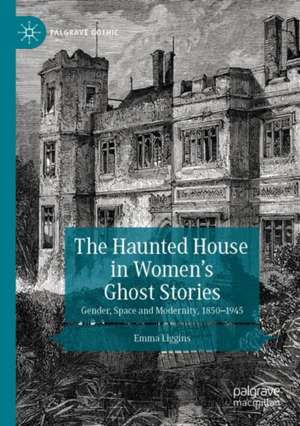The Haunted House in Women’s Ghost Stories: Gender, Space and Modernity, 1850–1945: Palgrave Gothic
Autor Emma Ligginsen Limba Engleză Paperback – iul 2021
| Toate formatele și edițiile | Preț | Express |
|---|---|---|
| Paperback (1) | 635.12 lei 6-8 săpt. | |
| Springer International Publishing – iul 2021 | 635.12 lei 6-8 săpt. | |
| Hardback (1) | 644.63 lei 6-8 săpt. | |
| Springer International Publishing – iul 2020 | 644.63 lei 6-8 săpt. |
Din seria Palgrave Gothic
- 9%
 Preț: 751.76 lei
Preț: 751.76 lei - 20%
 Preț: 626.81 lei
Preț: 626.81 lei -
 Preț: 280.08 lei
Preț: 280.08 lei -
 Preț: 351.66 lei
Preț: 351.66 lei - 20%
 Preț: 690.52 lei
Preț: 690.52 lei - 15%
 Preț: 584.10 lei
Preț: 584.10 lei - 18%
 Preț: 782.24 lei
Preț: 782.24 lei - 15%
 Preț: 694.22 lei
Preț: 694.22 lei - 15%
 Preț: 690.76 lei
Preț: 690.76 lei - 15%
 Preț: 586.88 lei
Preț: 586.88 lei -
 Preț: 210.55 lei
Preț: 210.55 lei -
 Preț: 351.11 lei
Preț: 351.11 lei - 18%
 Preț: 778.01 lei
Preț: 778.01 lei -
 Preț: 262.29 lei
Preț: 262.29 lei - 15%
 Preț: 640.24 lei
Preț: 640.24 lei - 18%
 Preț: 893.21 lei
Preț: 893.21 lei - 18%
 Preț: 733.65 lei
Preț: 733.65 lei -
 Preț: 231.01 lei
Preț: 231.01 lei -
 Preț: 233.35 lei
Preț: 233.35 lei -
 Preț: 190.31 lei
Preț: 190.31 lei - 18%
 Preț: 898.26 lei
Preț: 898.26 lei -
 Preț: 387.38 lei
Preț: 387.38 lei - 15%
 Preț: 704.04 lei
Preț: 704.04 lei - 15%
 Preț: 640.88 lei
Preț: 640.88 lei - 18%
 Preț: 724.32 lei
Preț: 724.32 lei - 18%
 Preț: 788.41 lei
Preț: 788.41 lei - 18%
 Preț: 731.59 lei
Preț: 731.59 lei -
 Preț: 389.70 lei
Preț: 389.70 lei - 18%
 Preț: 731.91 lei
Preț: 731.91 lei -
 Preț: 232.16 lei
Preț: 232.16 lei - 15%
 Preț: 586.05 lei
Preț: 586.05 lei - 15%
 Preț: 698.15 lei
Preț: 698.15 lei
Preț: 635.12 lei
Preț vechi: 747.20 lei
-15% Nou
Puncte Express: 953
Preț estimativ în valută:
121.53€ • 127.23$ • 100.56£
121.53€ • 127.23$ • 100.56£
Carte tipărită la comandă
Livrare economică 05-19 aprilie
Preluare comenzi: 021 569.72.76
Specificații
ISBN-13: 9783030407544
ISBN-10: 3030407543
Pagini: 307
Ilustrații: XIII, 307 p. 1 illus.
Dimensiuni: 148 x 210 x 23 mm
Greutate: 0.43 kg
Ediția:1st ed. 2020
Editura: Springer International Publishing
Colecția Palgrave Macmillan
Seria Palgrave Gothic
Locul publicării:Cham, Switzerland
ISBN-10: 3030407543
Pagini: 307
Ilustrații: XIII, 307 p. 1 illus.
Dimensiuni: 148 x 210 x 23 mm
Greutate: 0.43 kg
Ediția:1st ed. 2020
Editura: Springer International Publishing
Colecția Palgrave Macmillan
Seria Palgrave Gothic
Locul publicării:Cham, Switzerland
Cuprins
Introduction.- Chapter 1: Elizabeth Gaskell: Old Nurses, Illegitimacy and the Ancestral Rural Home.- Chapter 2: Margaret Oliphant: Disinheritance, Scottish properties and the haunted garden.- Chapter 3: Vernon Lee: The Rapture of Old Houses and Decadent Italy.- Chapter 4: The Horrors of Suburbia in the Ghost Stories of E. Nesbit.- Chapter 5: ‘Ghosts went out when Electricity Came In’: Technology and the Domestic Interior in Edith Wharton’s Ghost Stories.- Chapter 5: May Sinclair: Patriarchal Space and Haunted Libraries.- Chapter 7: Elizabeth Bowen: From the Suburban Villa to Bomb-Damaged London.- Conclusion.
Recenzii
“Liggins draws together the different strands in her account of the female ghost story, providing an exceptional introduction to this often over-looked and under researched genre. This book will be of interest to scholars of women’s writing, ghost stories, and nineteenth-century fiction, as well as the general reader. It is an excellent companion to two recently reprinted short-story collections introduced by Liggins: Twilight Stories (1879) by Rhoda Broughton and Charlotte Riddell’s Weird Stories (1882).” (Kathleen Beal, BAVS Newsletter, Vol. 22 (2), 2022)
“This well-written book is a much needed re-examination of female ghost story writers and their representations … . Emma Liggins’s book sheds light onto an often-overlooked area of work, appealing to both expert and neophyte researchers in the field of the Female Gothic ghost story.” (Richard Jorge Fernández, English Studies, September 27, 2021)
Notă biografică
Emma Liggins is Senior Lecturer at Manchester Metropolitan University. She has previously published Odd Women? Spinsters, Lesbians and Widows in British Women’s Fiction, 1850s-1930s (2014), as well as articles and chapters on Vernon Lee, Mary Elizabeth Braddon and modernist ghost stories.
Caracteristici
Explores representations of Victorian and modernist haunted houses in women’s ghost stories, 1850-1945, through the lens of spatial theory Uncovers the gendered dimensions of the architectural uncanny and the hauntedness of home Reconsiders the relations between gender, space and modernity in a transitional period
